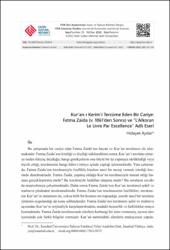Kur’an-ı Kerim’i Tercüme Eden Bir Cariye: Fatma Zaida (v. 1861’den Sonra) ve “L’Alkoran Le Livre Par Excellence” Adlı Eseri
Citation
AYDAR, Hidayet. "Kur’an-ı Kerim’i Tercüme Eden Bir Cariye: Fatma Zaida (v. 1861’den Sonra) ve “L’Alkoran Le Livre Par Excellence” Adlı Eseri." FSM İlmî Araştırmalar İnsan ve Toplum Bilimleri Dergisi, 20 (2022): 291-330.Abstract
Bu çalışmada bir cariye olan Fatma Zaida’nın hayatı ve Kur’an tercümesi ele alınmaktadır.
Fatma Zaida’nın kimliği ve kişiliği irdelendikten sonra, Kur’an’ı tercüme etmeye
neden ihtiyaç duyduğu; hangi gerekçelerin onu böyle bir işi yapmaya sürüklediği veya
teşvik ettiği, tercümesini hangi hâlet-i ruhiye içinde yaptığı işlenmektedir. Yine çalışmada,
Fatma Zaida’nın tercümesiyle özellikle kimlere nasıl bir mesaj vermek istediği üzerinde
durulmaktadır. Fatma Zaida, yapmış olduğu Kur’an tercümesiyle murad ettiği hususu
gerçekleştirmiş midir? Bu tercümeyle hedefine ulaşmış mıdır? Bu soruların cevabı
da araştırılmaya çalışılmaktadır. Daha sonra Fatma Zaida’nın Kur’an tercümesi şekil ve
muhteva yönünden incelenmektedir. Fatma Zaida’nın tercümesinin özellikleri, tercümenin
Kur’an’ın tamamını mı, yoksa belli bir kısmını mı kapsadığı, eserde nasıl bir tercüme
yöntemi uygulandığı da konu edilmektedir. Fatma Zaida’nın tercümesi şekil ve muhteva
açısından Kur’an’ın orijinaliyle karşılaştırılmakta; aradaki benzerlik ve farklılıklar ortaya
konmaktadır. Fatma Zaida tercümesinde sûrelere herhangi bir isim vermemiş, ayrıca sûre
içerisinde çok farklı bilgiler vermiştir. Kur’an metnindeki sûrelerle mukayesesi yapıla rak bunların hangi sûrelere tekabül ettiği tespit edilmeye çalışılmaktadır. Karşılaştırma
ve mukayeselerle Fatma Zaida’nın tercümesindeki fazlalıklar ve eksiklikler tespit edilmektedir.
Tercümesinde öne çıkan hususlar, üzerinde daha fazla durduğu konular da ele
alınmakta ve neden bu hususları daha çok önemsediği incelenmektedir. Böylece Fatma
Zaida’nın tercümesinin başarılı bir tercüme olup olmadığı değerlendirilmektedir. This study focuses on the life of Fatma Zaida, a concubine, and her translation of
the Qur’an. After analyzing Fatma Zaida’s identity and personality, the study examines
why she felt the need to translate the Qur’an, what motivated or encouraged her to do so,
and in what state of mind she made her translation. The study also focuses on who and
what kind of message Fatma Zaida wanted to convey through her translation. Did Fatma
Zaida realize what she intended with her translation of the Qur’an? Did she achieve her
goal with this translation? The answers to these questions are also tried to be investigated.
Then Fatma Zaida’s translation of the Qur’an is analyzed in terms of form and content.
The characteristics of Fatma Zaida’s translation, whether the translation covers the whole
Qur’an or a certain part of it, and what kind of translation method is applied in the work
are also discussed. Fatma Zaida’s translation is compared with the original Qur’an in terms
of form and content, and the similarities and differences between them are revealed.
Fatma Zaida did not give any names to the suras in her translation and gave very different
information within the suras. By making a comparison with the surahs in the Qur’anic
text, it is tried to determine which surahs they correspond to. Through comparisons, the
excesses and deficiencies in Fatma Zaida’s translation are identified. The issues that stand
out in her translation and the issues that she emphasized more are also discussed and the
reasons why she attached more importance to these issues are examined. Thus, it is also
evaluated whether Fatma Zaida’s translation is a successful translation or not.



















